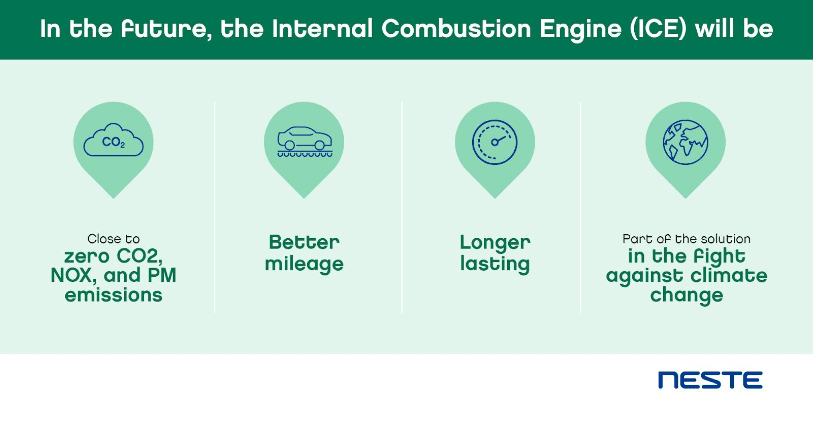Sustainable mobility opportunity in the US
The term sustainable mobility is about more than just reducing emissions. It is also about ensuring that our transportation system is safe, affordable and accessible so all Americans can enjoy a high quality of life and get where they need to go.

America’s transportation system today does not do this. Mobility, in all forms, has been dominated by fossil fuels for over 200 years. In 2020 alone, about 4 billion barrels of petroleum products were used for the US transportation sector, making it the nation’s largest source of greenhouse gas (GHG) emissions. This is not a point for debate - data shows that natural disasters and health impacts from the burning of fossil fuels cause nearly $820 billion dollars in harm to the economy every year. In the worst cases, people’s lives are upended or even lost. To transition to sustainable mobility, the phase out of fossil fuel is the most crucial step that cities and businesses should take.
New low and zero emission technologies make it possible to accelerate the transition to a sustainable, low carbon transportation system. From electrification to renewable fuels to high-speed rails - many solutions are emerging to create a smart, convenient transportation system that increases the sustainability of vehicles and cities. At Neste, we believe all solutions are needed to help us transition away from fossil fuels faster.
The simple truth is that there is no silver bullet for kicking the fossil fuel habit because what works for one type of vehicle will not work for another. For example, electrification makes sense for passenger cars, but not for heavy duty trucks or aircraft.
The most challenging vehicles to get to zero emissions are the ones most important to our high quality of life. Big rigs power the supply chains that in turn power our economy, and these vehicles run on fossil diesel. Aircraft shrink the world so we can get from point A to point B in hours instead of days, but depend on fossil jet fuel. Many components in vehicles feature plastic components made from crude oil and gas. Collectively, these hard to abate parts of our transport systems need today solutions that can seamlessly work right now.
Sustainable Freight Transportation

In the US, there are more than 13.5 million medium and heavy duty trucks in service today and most of them rely on fossil fuels. These vehicles are responsible for moving 72% of all the goods we consume - such as the orders we place on Amazon that are later delivered at our doorstep, or the fresh groceries we buy from the local markets - but they burn over 44 billion gallons of diesel fuel every year, emitting 432 million metric tons of GHG emissions. The use of fossil fuel not only contributes to climate change, but generates other emissions that cause premature deaths. In 2016, ozone and fine particulate matter from older vehicles without modern pollution controls caused over 7,100 deaths in 12 states in the Northeast and Mid-Atlantic regions of the US. These emissions also travel across state lines, harming the health of people living in cities and states downwind.
Reducing emissions from road transportation and phasing out fossil fuels can save lives. A number of solutions are emerging, or have matured in the past decade, to contribute to sustainable road freight transportation, such as electric trucks, hydrogen fuel cell trucks, and using renewable fuels to power existing fleets. However, as of late 2020, deployed zero-emission trucks only made up 0.005% of the fleet. Regulatory support and the reducing cost of batteries are expected to further boost this number, but trucks with combustion engines will continue to dominate the commercial trucking sector in the foreseeable future.
Our communities and planet can’t afford to wait - we need today solutions to cut emissions and pollution from these vehicles. The combination of modern diesel engines and renewable diesel is an effective, proven way to do this.
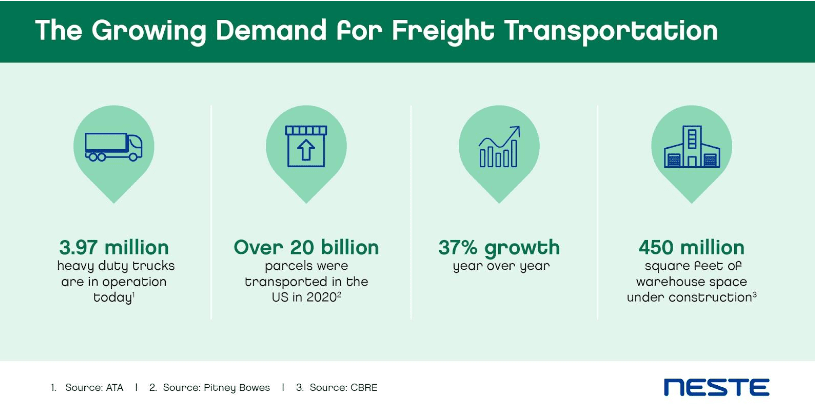
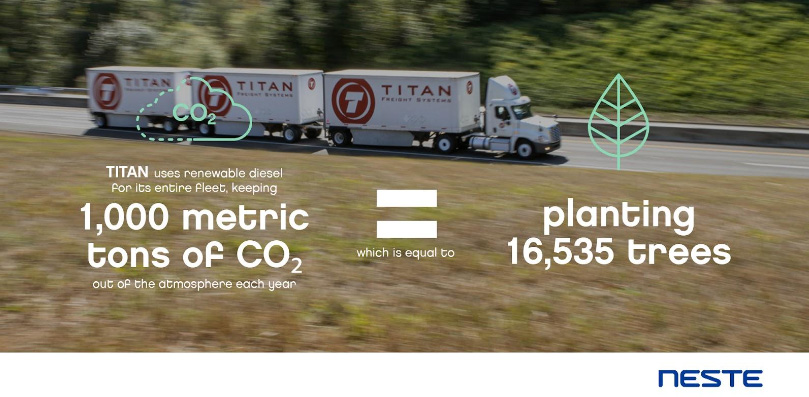
In California alone, the use of renewable diesel in the transportation sector accounted for 30% of the state's GHG reductions. Additionally, a modern diesel engine is shown to reduce NOx emissions by 99% and particulate emissions by 98%. Given the long lifetime of heavy-duty vehicles, using renewable diesel allows these trucks to continue running with much lower emissions without disrupting the convenience that we treasure today.
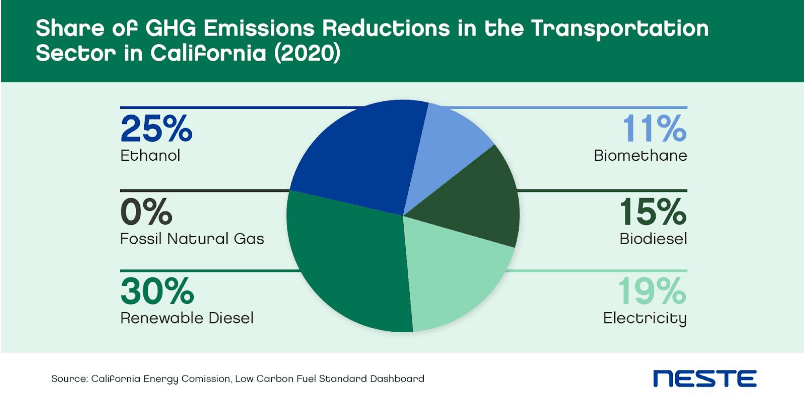
Public transportation
Public transportation is essential for Americans' livelihood. It provides access to employment, community resources, medical care, and recreational opportunities in communities. It is also part of the solution in the fight against climate change as travelling by public transportation uses less energy and produces less pollution than comparable travel in private vehicles. To meet the goals of the Paris agreement, which is to limit the average global temperature rise to 1.5°C above pre-industrial levels, a number of city leaders suggest that the use of public transit needs to double by 2030.
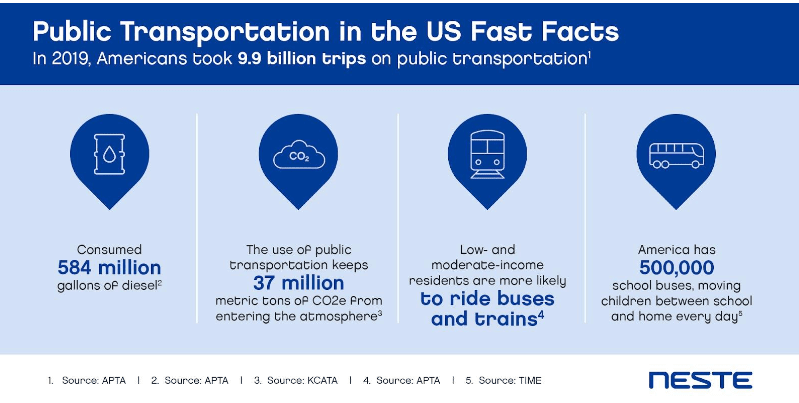
The most common types of public transportation in the US are buses, subways, and light rails. Transit agencies across the nation are increasingly taking actions to reduce their own carbon emissions to further the GHG emission reduction benefits associated with public transportation. Across the US, 169 public transit agencies have signed up for the Federal Transit Administration’s Sustainable Transit for a Healthy Planet Challenge, which encourages them to take bold actions and investments to cut GHG emissions - and many of these agencies are adopting zero-emission buses or transitioning to alternative fuel sources.
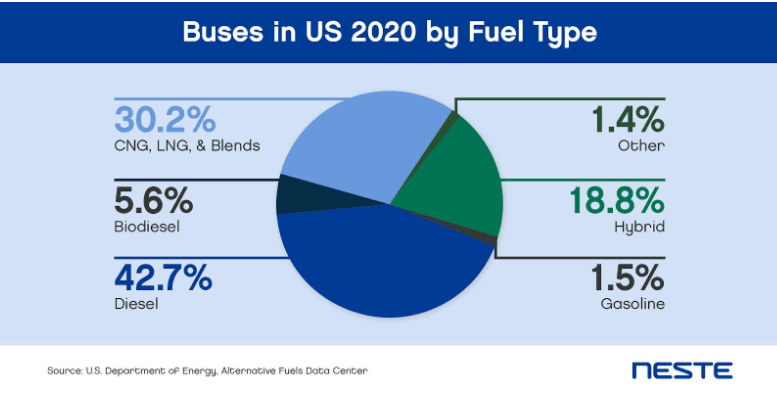
In 2021, the number of zero-emission buses in the US saw a 27% increase to 3,533, compared with 2020 data. Though maturing technologies and reducing costs will continue driving the adoption of electric and hydrogen fuel cell buses, research suggests that the transit bus fleet in the US would need between $56.22 billion and $88.91 billion investment to transition to full zero-emission vehicles by 2035. Renewable fuels, in this case, can be used as a cost-effective, available-today alternative to transition the existing over 30,000 diesel transit buses from fossil fuel dependent to not emitting new carbon emissions from the tailpipe overnight. The use of renewable fuels and modern diesel engines can also significantly reduce emissions of particulate matter, NOx and other pollutants, improving air quality for people who rely on public transportation the most - such as people from economically disadvantaged communities who are already disproportionately exposed to air pollution.
One example of buses that many of us have personal experiences with are school buses. There are more than 500,000 school buses on the road in the United States providing safe transportation to and from school for more than 25 million children every day. 95 percent of these school buses are powered by diesel engines because of their reliability, durability and safety. Battery-powered school buses currently account for less than 1% of America’s fleet of half a million school buses, and it may take longer to become viable nationwide, so replacing fossil diesel with renewable fuels that are available at scale today can provide immediate benefits.
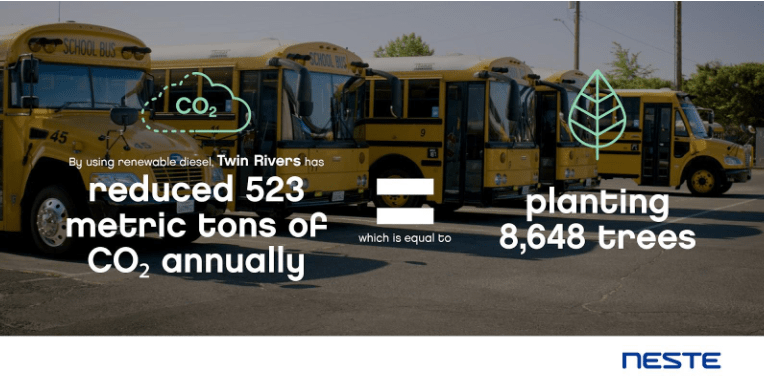
Aviation

Air travel allows us to have adventures in new countries, to enjoy the breezes on tropical beaches, to visit historical places, to build business relationships and to reunite with friends and family. However, flying is currently recognized for its contribution to climate change - accounting for 3% of global emissions today. This number could rise in the next few decades, with air travelers in the US forecasted to increase from 1.06 billion in 2020 to 1.47 billion in 2040. More planes and passengers means more GHG emissions if we continue business as usual. While some are calling for an end to air travel, Neste believes there are actions we can take now to make flights more sustainable and ensure future generations can enjoy the many benefits of air travel.
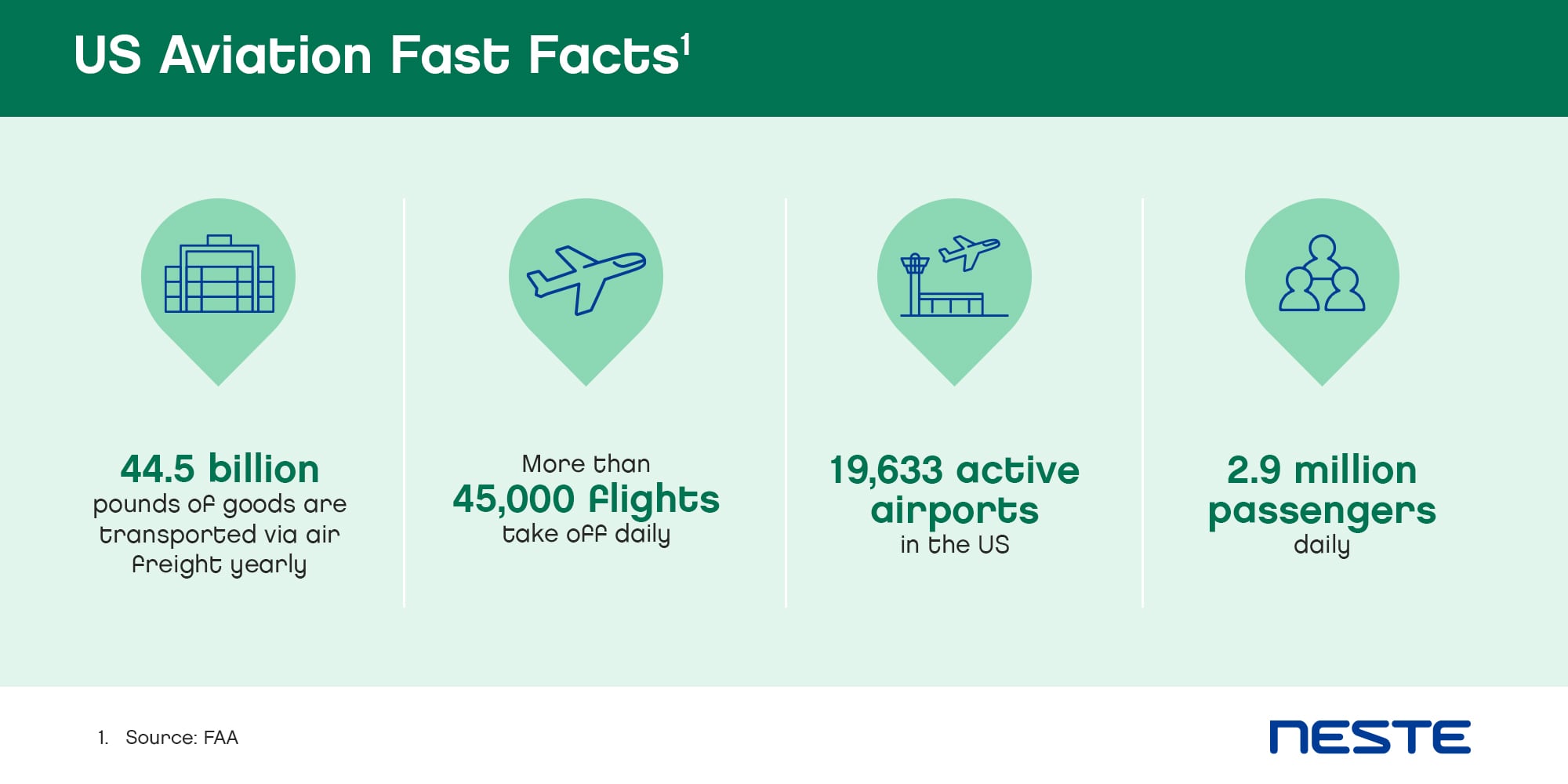
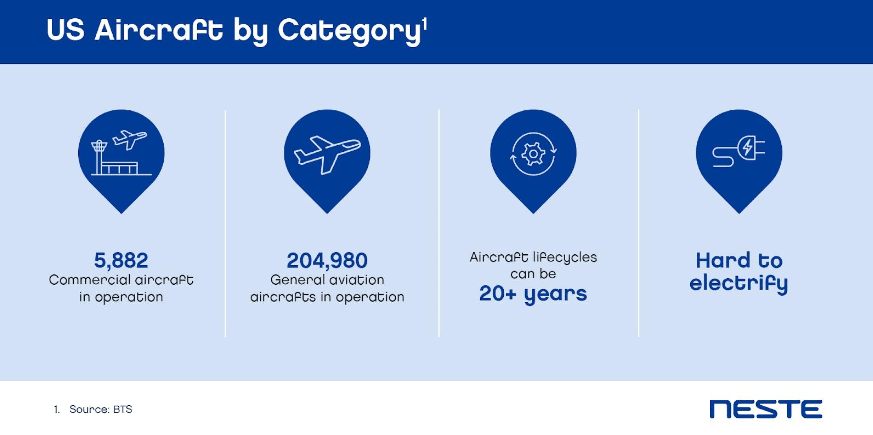
President Joe Biden’s administration calls for the US aviation sector to reach net-zero emissions by 2050. While electric and hydrogen-powered aviation may unlock affordable and convenient local and regional travel, these technologies are likely to take decades to mature. For now, sustainable aviation fuel (SAF) is the only viable solution to reduce GHG emissions from flying. It is critical to the aviation industry’s ability to meet the net-zero emissions goal.
Right now, SAF must be blended with conventional jet fuel, but they have the potential, on a lifecycle basis, to slash emissions by up to 100 percent if used in neat form. SAF can be used in today’s fleet of aircraft, without modification, and can be produced from a wide range of feedstocks, including wastes, residues, biomass, and a new generation of raw materials such as algae and forestry waste. As investments and R&D efforts continue to focus mainly on scaling production and lowering cost, this low-carbon, drop-in fuel is poised to chart a course to net-zero aviation emissions by 2050.
Advanced Technologies
In addition to leveraging zero emission technologies and low-carbon fuels, advanced communication technologies also have a role to play in sustainable mobility. Technologies such as artificial intelligence, machine learning, 5G and IoT are being widely used to make transportation smarter in multiple ways: navigation systems help freight companies and drivers find the most efficient route, reducing fuel consumption; interactive mobile applications make public transportation more convenient for riders by providing information on schedules for trains and buses; mobile alerts for drivers to avoid hazardous road conditions and enhance safety.
Manufacturers are also developing fast charging technologies. In a few years, EV owners will be able to recharge their electric car as fast and easily as a traditional gasoline fill-up. In the meantime, modern internal combustion engines (ICE) that are more efficient than ever are also evolving. All medium- to heavy-duty truck manufacturers stepped up with efficiency improvements of 3-6% to meet EPA requirements for GHG21. Once combined with renewable low-carbon fuels, these modern ICE can help increase the speed of the transition towards zero emissions while guaranteeing safety and reliability.
Automakers are racing to make their vehicles more sustainable by using less materials that are hard to recycle. Now, plastic waste from the ocean, rice hulls, flaxseeds and agave are transforming the manufacturing process. For example, recycled materials make up 29% of a BMW vehicle. As we continue to tackle the problems of plastic waste, the cars that we drive tomorrow will possibly be made from the PET bottles we recycle today.
Access to mobility and safety
Sustainable mobility also includes the important notions of access to mobility and reduction of air pollution, which often disproportionately impact some racial or ethnic groups. An EPA study finds people of color experience greater than average exposures to almost all emission source types, causing lung and heart problems. Burning harmful fossil fuels is the root cause of this problem, but the good news is that multiple solutions can be part of solving the puzzle. The transition to EVs will help significantly reduce harmful pollutants - the American Lung Association predicts a total of 30,599 tons of particle pollution will be reduced in a scenario that we transition nationwide to electric transportation.
While the EV market continues to grow, the use of renewable fuels in vehicles and planes can contribute to cleaner air today. This is especially true for rural communities that live close to major roadways, airports, industrial facilities and construction sites, as renewable fuels effectively reduce engine out NOx and particulate matter emissions from heavy duty vehicles, aircraft and equipment. For example, aviation accounts for around 2.5% of global CO2 emissions, but its overall contribution to climate change is higher. An important contributor to this is contrail cirrus clouds caused by soot particles. SAF can reduce soot particles by 50% to 70% and also does not produce any SOx emissions, providing benefits to both employees who work on the tarmac and to the surrounding communities.
Sustainable mobility should also include equity in accessibility, with particular attention to more vulnerable groups of the population and geographical areas at risk of social exclusion.
American businesses and cities can reduce transportation-related emissions today
For around 200 years, we have relied on fossil sources to power transportation, and this needs to come to an end. The growth of clean transportation technologies will continue, driving American businesses and cities to join forces to fight climate change and make mobility more sustainable. While battery-electric and hydrogen technologies are poised to continue maturing in the next few years, companies and governments can choose to act today by implementing clean fuels in the sectors of heavy-duty trucking, school, and public transportation to reduce emissions from existing fleet total cost of ownership.

